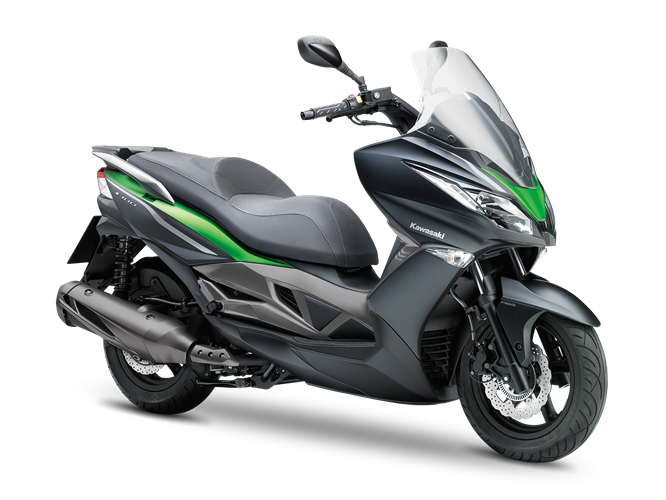The Kawasaki J300 is built in partnership with Kemco and is based on the Downtown 300.
Yet Kawasaki has totally redesigned the Kemco scooter to make it a real Kawasaki. The changes include a redesign of the bodywork, brake hoses, the silencer, the seat, adjustable brake levers, rear footrests, brake callipers, footboards, the screen headlamps and clocks, to name but a few changes.
At £4,049 for the base model, you may think that the Kawasaki J300 is a little over priced but it is not. This price makes for good value for money and it is also relatively cheap to run, with good fuel economy, low maintenance costs and small insurance premiums. The SE model at £4,149 introduces the Kawasaki green finish and the ABS model at £4,499 is the one to go for if you can stretch your budget that far.
The Kawasaki engineers have developed a new ECU which gives the scooter some decent mid-range punch. You can certainly feel it when it accelerates, defying its meagre 27bhp. On the road though, the scooter performs well with enough urge to overtake comfortably from 60-70mph. The weight of the bike (191kg) means that at all speeds it is very stable. Even on a windy day the Kawasaki J300 does not feel affected by sudden gusts.
The Kawasaki J300 is more like a tourer as you can just sit back in its wide, comfortable seat and cruise around town with ease. The clocks are basic with a speedo, rev counter, and fuel gauge.
Under the seat you can stow a set of waterproofs and a helmet and there’s even a hook to carry your shopping. Most pleasing is that the bike is really well finished with plenty of reminders that you’re riding a real Kawasaki.
The J300 is not revolutionary but it handles faster roads very well and is ideal as a daily commute vehicle. What is more, it is also very well put together. Despite its size, the J300 is extremely manoeuvrable about town.
It is simplicity itself to ride, very stable, offers a comfortable ride and stops well with good brakes, especially if you opt for the ABS version. Its size also makes it suitable for longer distance commutes even on motorways.
Commuting on a tight budget on two wheels doesn’t have to be soul destroying, not with scooters like the Kawasaki J300 around. It comes with a two-year warranty, a year’s roadside assistance and some new finance deals thrown in.
This is a very good machine and expect the Kawasaki J300 to sell in large numbers all over the world.
Facts & figures
Bike: Kawasaki J300
Price: £4,049 Base Model, £4,149 SE model, £4,499 ABS model
Engine: 299cc 4-stroke single
Weight: 191kg
Power: 27bhp
Seat height: 775mm
Tank size: 13 litres
